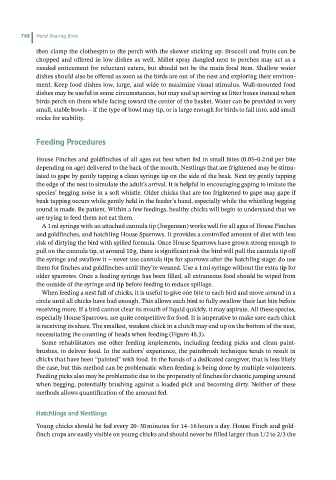Page 746 - Hand rearing birds second
P. 746
748 Hand-Rearing Birds
then clamp the clothespin to the perch with the skewer sticking up. Broccoli and fruits can be
chopped and offered in low dishes as well. Millet spray dangled next to perches may act as a
needed enticement for reluctant eaters, but should not be the main food item. Shallow water
dishes should also be offered as soon as the birds are out of the nest and exploring their environ-
ment. Keep food dishes low, large, and wide to maximize visual stimulus. Wall‐mounted food
dishes may be useful in some circumstances, but may end up serving as litter boxes instead when
birds perch on them while facing toward the center of the basket. Water can be provided in very
small, stable bowls – if the type of bowl may tip, or is large enough for birds to fall into, add small
rocks for stability.
Feeding Procedures
House Finches and goldfinches of all ages eat best when fed in small bites (0.05–0.2 ml per bite
depending on age) delivered to the back of the mouth. Nestlings that are frightened may be stimu-
lated to gape by gently tapping a clean syringe tip on the side of the beak. Next try gently tapping
the edge of the nest to simulate the adult’s arrival. It is helpful in encouraging gaping to imitate the
species’ begging noise in a soft whistle. Older chicks that are too frightened to gape may gape if
beak tapping occurs while gently held in the feeder’s hand, especially while the whistling begging
sound is made. Be patient. Within a few feedings, healthy chicks will begin to understand that we
are trying to feed them not eat them.
A 1 ml syringe with an attached cannula tip (Jorgensen) works well for all ages of House Finches
and goldfinches, and hatchling House Sparrows. It provides a controlled amount of diet with less
risk of dirtying the bird with spilled formula. Once House Sparrows have grown strong enough to
pull on the cannula tip, at around 10 g, there is significant risk the bird will pull the cannula tip off
the syringe and swallow it – never use cannula tips for sparrows after the hatchling stage; do use
them for finches and goldfinches until they’re weaned. Use a 1 ml syringe without the extra tip for
older sparrows. Once a feeding syringe has been filled, all extraneous food should be wiped from
the outside of the syringe and tip before feeding to reduce spillage.
When feeding a nest full of chicks, it is useful to give one bite to each bird and move around in a
circle until all chicks have had enough. This allows each bird to fully swallow their last bite before
receiving more. If a bird cannot clear its mouth of liquid quickly, it may aspirate. All these species,
especially House Sparrows, are quite competitive for food. It is imperative to make sure each chick
is receiving its share. The smallest, weakest chick in a clutch may end up on the bottom of the nest,
necessitating the counting of heads when feeding (Figure 48.3).
Some rehabilitators use other feeding implements, including feeding picks and clean paint-
brushes, to deliver food. In the authors’ experience, the paintbrush technique tends to result in
chicks that have been “painted” with food. In the hands of a dedicated caregiver, that is less likely
the case, but this method can be problematic when feeding is being done by multiple volunteers.
Feeding picks also may be problematic due to the propensity of finches for chaotic jumping around
when begging, potentially brushing against a loaded pick and becoming dirty. Neither of these
methods allows quantification of the amount fed.
Hatchlings and Nestlings
Young chicks should be fed every 20–30 minutes for 14–16 hours a day. House Finch and gold-
finch crops are easily visible on young chicks and should never be filled larger than 1/2 to 2/3 the

